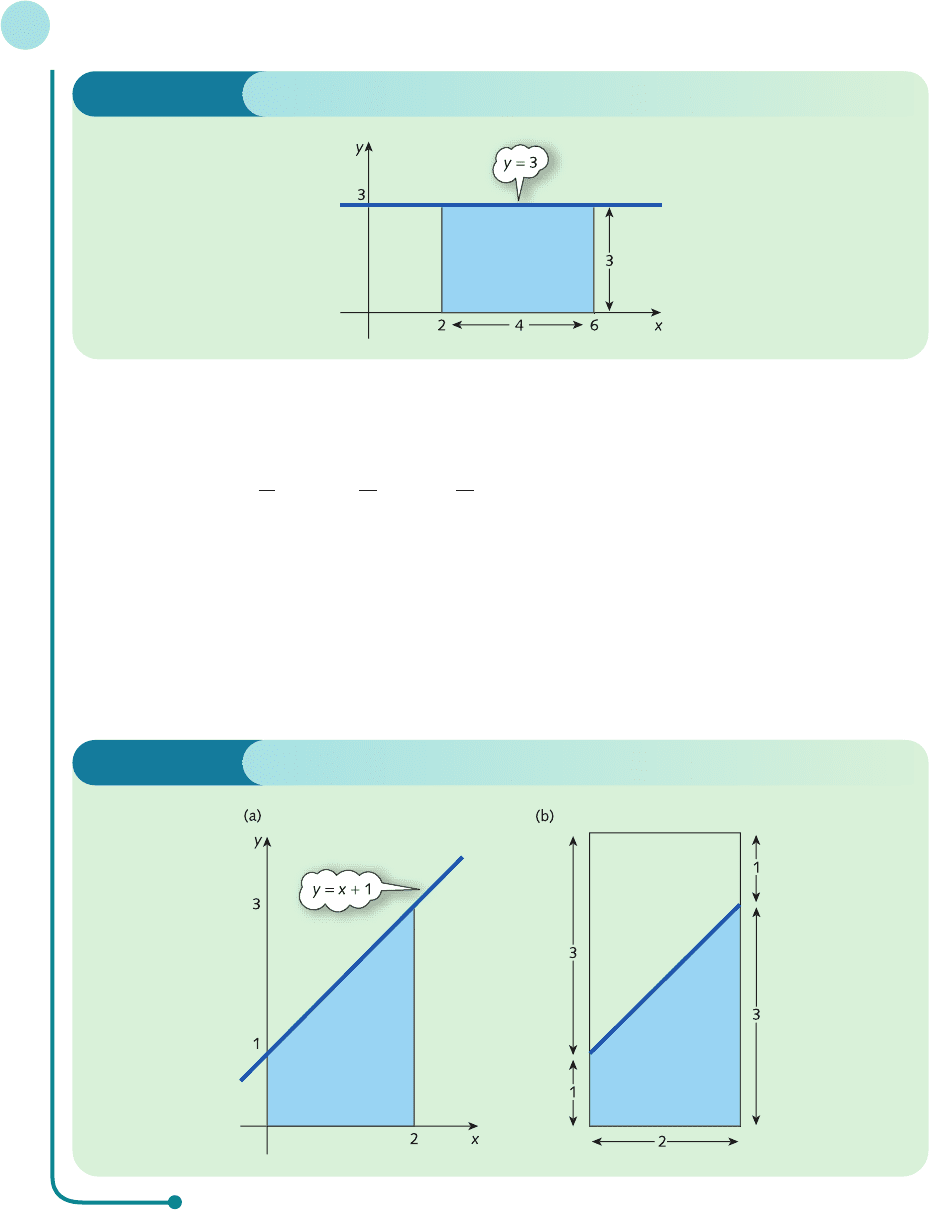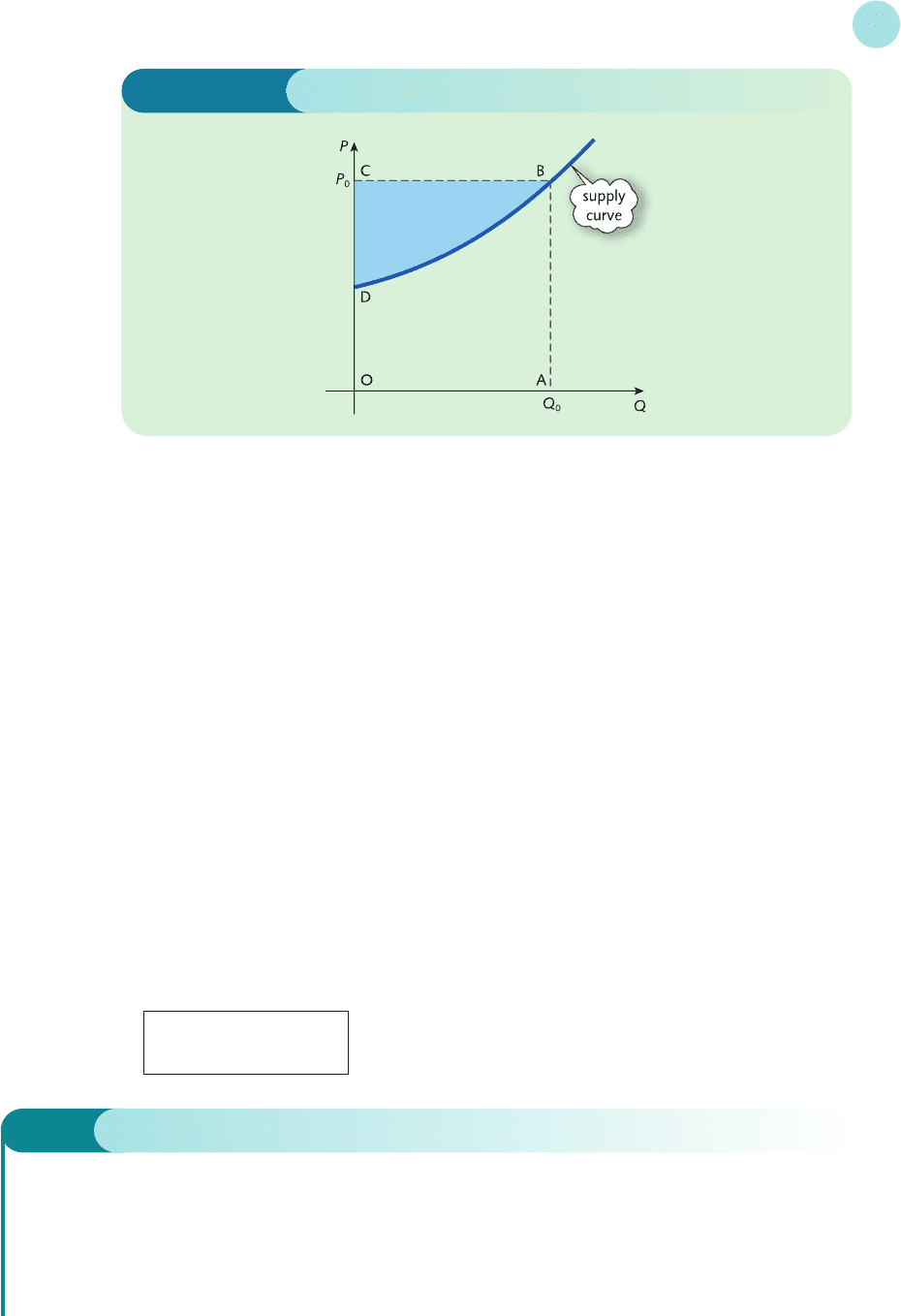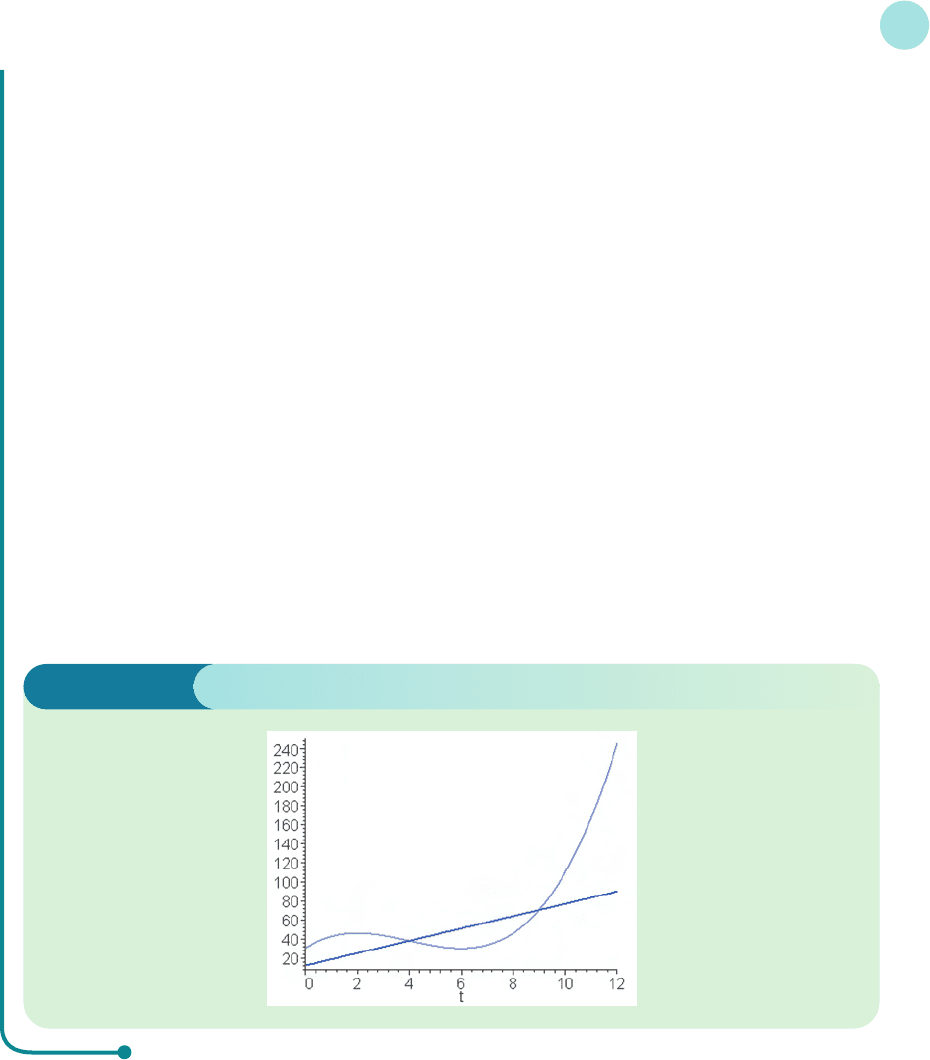Jacques I. Mathematics for Economics and Business
Подождите немного. Документ загружается.


which gives
area = 4 × 3 = 12 ✓
(b)
2
0
(x + 1)dx = + x
2
0
=+2 −+0 = 4
Again this value can be confirmed graphically. Figure 6.5(a) shows the region under the graph of
y = x + 1 between x = 0 and x = 2. This can also be regarded as one-half of the rectangle illustrated in
Figure 6.5(b). This rectangle has a base of 2 units and a height of 4 units, so has area
2 × 4 = 8
The area of the region shown in Figure 6.5(a) is therefore
1
/
2
× 8 = 4 ✓
D
F
0
2
2
A
C
D
F
2
2
2
A
C
J
L
x
2
2
G
I
Integration
440
Figure 6.5
Figure 6.4
In this example we deliberately chose two very simple functions so that we could demon-
strate the fact that definite integrals really do give the areas under graphs. The beauty of the
integration technique, however, is that it can be used to calculate areas under quite complicated
functions for which alternative methods would fail to produce the exact value.
MFE_C06b.qxd 16/12/2005 11:21 Page 440

To illustrate the applicability of definite integration we concentrate on four topics:
consumer’s surplus
producer’s surplus
investment flow
discounting.
We consider each of these in turn.
6.2.1 Consumer’s surplus
The demand function, P = f(Q), sketched in Figure 6.6, gives the different prices that con-
sumers are prepared to pay for various quantities of a good. At Q = Q
0
the price P = P
0
. The
total amount of money spent on Q
0
goods is then Q
0
P
0
, which is given by the area of the rect-
angle OABC. Now, P
0
is the price that consumers are prepared to pay for the last unit that they
buy, which is the Q
0
th good. For quantities up to Q
0
they would actually be willing to pay the
higher price given by the demand curve. The shaded area BCD therefore represents the benefit
to the consumer of paying the fixed price of P
0
and is called the consumer’s surplus, CS. The
value of CS can be found by observing that
area BCD = area OABD − area OABC
6.2 • Definite integration
441
Figure 6.6
Practice Problem
1 Evaluate the following definite integrals:
(a)
1
0
x
3
dx (b)
5
2
(2x − 1)dx (c)
4
1
(x
2
− x + 1)dx (d)
1
0
e
x
dx
MFE_C06b.qxd 16/12/2005 11:21 Page 441

The area OABD is the area under the demand curve P = f(Q), between Q = 0 and Q = Q
0
, and
so is equal to
0
Q
0
f(Q)dQ
The region OABC is a rectangle with base Q
0
and height P
0
so
area OABC = Q
0
P
0
Hence
CS =
0
Q
0
f(Q)dQ − Q
0
P
0
Integration
442
Practice Problem
2 Find the consumer’s surplus at Q = 8 for the demand function
P = 100 − Q
2
Example
Find the consumer’s surplus at Q = 5 for the demand function
P = 30 − 4Q
Solution
In this case
f(Q) = 30 − 4Q
and Q
0
= 5. The price is easily found by substituting Q = 5 into
P = 30 − 4Q
to get
P
0
= 30 − 4(5) = 10
The formula for consumer’s surplus
CS =
0
Q
0
f(Q)dQ − Q
0
P
0
gives
CS =
5
0
(30 − 4Q)dQ − 5(10)
= [30Q − 2Q
2
]
5
0
− 50
= [30(5) − 2(5)
2
] − [30(0) − 2(0)
2
] − 50
= 50
MFE_C06b.qxd 16/12/2005 11:21 Page 442

6.2.2 Producer’s surplus
The supply function, P = g(Q), sketched in Figure 6.7 gives the different prices at which pro-
ducers are prepared to supply various quantities of a good. At Q = Q
0
the price P = P
0
. Assuming
that all goods are sold, the total amount of money received is then Q
0
P
0
, which is given by the
area of the rectangle OABC.
Now, P
0
is the price at which the producer is prepared to supply the last unit, which is the
Q
0
th good. For quantities up to Q
0
they would actually be willing to accept the lower price given
by the supply curve. The shaded area BCD therefore represents the benefit to the producer of
selling at the fixed price of P
0
and is called the producer’s surplus, PS. The value of PS is found
by observing that
area BCD = area OABC − area OABD
The region OABC is a rectangle with base Q
0
and height P
0
, so
area OABC = Q
0
P
0
The area OABD is the area under the supply curve P = g(Q), between Q = 0 and Q = Q
0
, and so
is equal to
0
Q
0
g(Q)dQ
Hence
PS = Q
0
P
0
−
0
Q
0
g(Q)dQ
6.2 • Definite integration
443
Figure 6.7
Example
Given the demand function
P = 35 − Q
2
D
and supply function
P = 3 + Q
2
S
find the producer’s surplus assuming pure competition.
MFE_C06b.qxd 16/12/2005 11:21 Page 443

Solution
On the assumption of pure competition, the price is determined by the market. Before we can calculate the
producer’s surplus we therefore need to find the market equilibrium price and quantity. Denoting the com-
mon value of Q
D
and Q
S
by Q, the demand and supply functions are
P = 35 − Q
2
and
P = 3 + Q
2
so that
35 − Q
2
= 3 + Q
2
(both sides are equal to P)
35 − 2Q
2
= 3 (subtract Q
2
from both sides)
−2Q
2
=−32 (subtract 35 from both sides)
Q
2
= 16 (divide both sides by −2)
which has solution Q =±4. We can obviously ignore the negative solution because it does not make
economic sense. The equilibrium quantity is therefore equal to 4. The corresponding price can be found by
substituting this into either the demand or the supply equation. From the demand equation we have
P
0
= 35 − (4)
2
= 19
The formula for the producer’s surplus,
PS = Q
0
P
0
−
0
Q
0
g(Q)dQ
gives
PS = 4(19) −
4
0
(3 + Q
2
)dQ
= 76 − 3Q +
4
0
= 76 − {[3(4) +
1
/3(4)
3
] − [3(0) −
1
/3(0)
3
]}
= 42
2
/3
J
L
Q
3
3
G
I
Integration
444
Practice Problem
3 Given the demand equation
P = 50 − 2Q
D
and supply equation
P = 10 + 2Q
S
calculate
(a) the consumer’s surplus
(b) the producer’s surplus
assuming pure competition.
MFE_C06b.qxd 16/12/2005 11:21 Page 444

6.2.3 Investment flow
Net investment, I, is defined to be the rate of change of capital stock, K, so that
I =
Here I(t) denotes the flow of money, measured in dollars per year, and K(t) is the amount of
capital accumulated at time t as a result of this investment flow and is measured in dollars.
Given a formula for capital stock in terms of time, we simply differentiate to find net invest-
ment. Conversely, if we know the net investment function then we integrate to find the capital
stock. In particular, to calculate the capital formation during the time period from t = t
1
to
t = t
2
we evaluate the definite integral
t
2
t
1
I(t )dt
dK
dt
6.2 • Definite integration
445
Example
If the investment flow is
I(t) = 9000 t
calculate
(a) the capital formation from the end of the first year to the end of the fourth year
(b) the number of years required before the capital stock exceeds $100 000.
Solution
(a) In this part we need to calculate the capital formation from t = 1 to t = 4, so we evaluate the definite
integral
4
1
9000 t dt= 9000
4
1
t
1/2
dt
= 9000 t
3/2
4
1
= 9000 (4)
3/2
− (1)
3/2
= 9000 −
= $42 000
(b) In this part we need to calculate the number of years required to accumulate a total of $100 000. After
T years the capital stock is
T
0
9000 t dt = 9000
T
0
t
1/ 2
dt
We want to find the value of T so that
9000
T
0
t
1/ 2
dt = 100 000
D
F
2
3
16
3
A
C
J
L
2
3
2
3
G
I
J
L
2
3
G
I
MFE_C06b.qxd 16/12/2005 11:21 Page 445

The integral is easily evaluated as
9000 t
3/2
T
0
= 9000 T
3/2
− (0)
3/2
= 6000T
3/2
so T satisfies
6000T
3/2
= 100 000
This non-linear equation can be solved by dividing both sides by 6000 to get
T
3/2
= 16.67
and then raising both sides to the power of
2
/3
, which gives
T = 6.5
The capital stock reaches the $100 000 level about halfway through the seventh year.
D
F
2
3
2
3
A
C
J
L
2
3
G
I
Integration
446
Practice Problem
4 If the net investment function is given by
I(t) = 800t
1/3
calculate
(a) the capital formation from the end of the first year to the end of the eighth year
(b) the number of years required before the capital stock exceeds $48 600.
Example
During the next year, a firm’s revenue and cost flows, measured in thousands of dollars per month, are to
be modelled by
r(t) = 0.5t
3
− 6t
2
+ 18t + 30 and c(t) = 6.5t + 12
respectively.
(1) Evaluate the definite integrals
(a)
4
0
(r − c)dt (b)
9
4
(r − c)dt
(2) Plot a graph of r(t) and c(t) on the same diagram and hence interpret the values obtained in part (1).
Solution
(1) We begin by naming these expressions r and c by typing
>r:=0.5*t^3–6*t^2+18*t+30;
and
>c:=6.5*t+12;
MAPLE
MFE_C06b.qxd 16/12/2005 11:21 Page 446

(a) To evaluate the definite integral ∫
4
0
(r − c)dt, we use the instruction int as before, except that we
now specify the limits, 0 and 4. We type
>int(r-c,t=0..4);
which gives the answer
68
(b) Similarly, the second integral is evaluated by editing the instruction as:
>int(r-c,t=4..9);
which gives
–78.125
(2) To plot both r and c on the same diagram, type
>plot({r,c},t=0..12);
The result is sketched in Figure 6.8.
Now, r(t) represents the rate of change of revenue with respect to time, so the revenue itself is the area
under the graph of r(t). Similarly, the area under the graph of c(t) determines the total cost. Hence the
area between the two curves gives the predicted profit during that time period. Figure 6.8 shows that
between t = 0 and t = 4 revenue exceeds costs, so the firm is likely to make a positive profit of $68 000.
On the other hand, between t = 4 and t = 9 the graph of c(t) lies above that of r(t), which explains why
the value of the integral is negative. During this period the firm is expected to make a loss of $78 125.
6.2 • Definite integration
447
6.2.4 Discounting
In Chapter 3 the formula
P = Se
−rt / 100
was used to calculate the present value, P, when a single future value, S, is discounted at r%
interest continuously for t years. We also discussed the idea of an annuity. This is a fund that
provides a series of discrete regular payments and we showed how to calculate the original
lump sum needed to secure these payments for a prescribed number of years. This amount is
Figure 6.8
MFE_C06b.qxd 16/12/2005 11:21 Page 447

called the present value of the annuity. If the fund is to provide a continuous revenue stream
for n years at an annual rate of S dollars per year then the present value can be found by eval-
uating the definite integral
P =
n
0
Se
−rt / 100
dt
Integration
448
Practice Problem
5 Calculate the present value of a continuous revenue stream for 10 years at a constant rate of $5000
per year if the discount rate is 6%.
Example
Calculate the present value of a continuous revenue stream for 5 years at a constant rate of $1000 per year
if the discount rate is 9%.
Solution
The present value is found from the formula
P =
n
0
Se
−rt/100
dt
with S = 1000, r = 9 and n = 5, so
P =
5
0
1000e
− 0.09t
dt
= 1000
5
0
e
− 0.09t
dt
= 1000 − e
− 0.09t
5
0
=− [e
− 0.09t
]
5
0
=− (e
− 0.45
− 1)
= $4026.35
1000
0.09
1000
0.09
J
L
1
0.09
G
I
MFE_C06b.qxd 16/12/2005 11:21 Page 448

6.2 • Definite integration
449
Consumer’s surplus The excess cost that a person would have been prepared to pay for
goods over and above what is actually paid.
Definite integral The number ∫
b
a
f(x)dx which represents the area under the graph of f (x)
between x = a and x = b.
Limits of integration The numbers a and b which appear in the definite integral, ∫
b
a
f(x)dx.
Net investment Rate of change of capital stock over time: I = dK/dt.
Producer’s surplus The excess revenue that a producer has actually received over and
above the lower revenue that it was prepared to accept for the supply of its goods.
Key Terms
Practice Problems
6 Find the area under the graph of
f(x) = 4x
3
− 3x
2
+ 4x + 2
between x = 1 and x = 2.
7 Evaluate each of the following definite integrals:
(a)
2
0
x
3
dx (b)
2
−2
x
3
dx
By sketching a rough graph of the cube function between and x =−2 and 2, suggest a reason for your
answer to part (b). What is the actual area between the x axis and the graph of y = x
3
over this range?
8 (Maple)
(a) Plot a graph of y = on 1 ≤ x ≤ 30.
Evaluate
N
1
dx in the cases when N is 2, 20 and 200.
What do these results suggest about the value of
∞
1
dx?
(b) Repeat part (a) for the function y = .
9 (Maple)
(a) Plot a graph of y = on 0.01 ≤ x ≤ 1.
Evaluate
1
N
dx in the cases when N is 0.1, 0.01 and 0.001.
What do these results suggest about the value of
1
0
dx?
(b) Repeat part (a) for the function y = .
1
x
2
1
x
1
x
1
x
1
x
1
x
2
1
x
2
1
x
2
MFE_C06b.qxd 16/12/2005 11:21 Page 449
